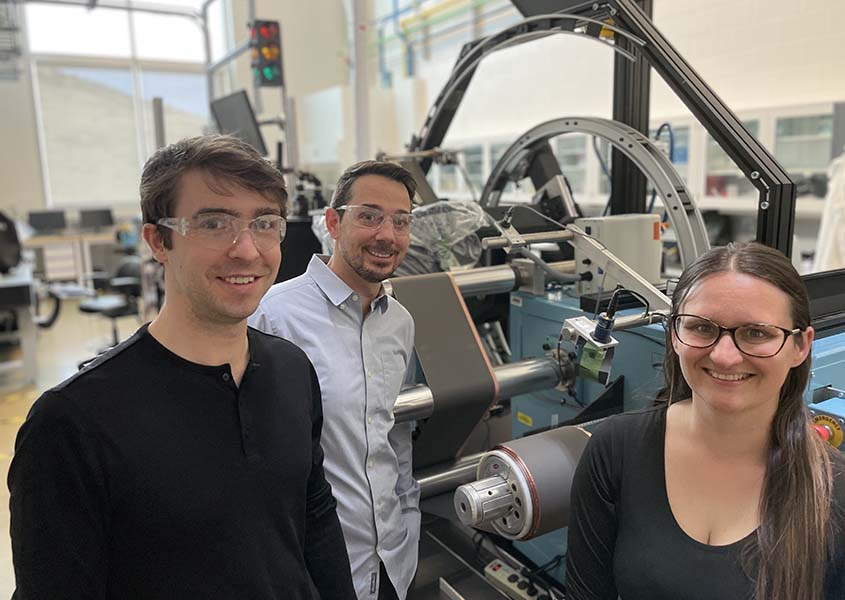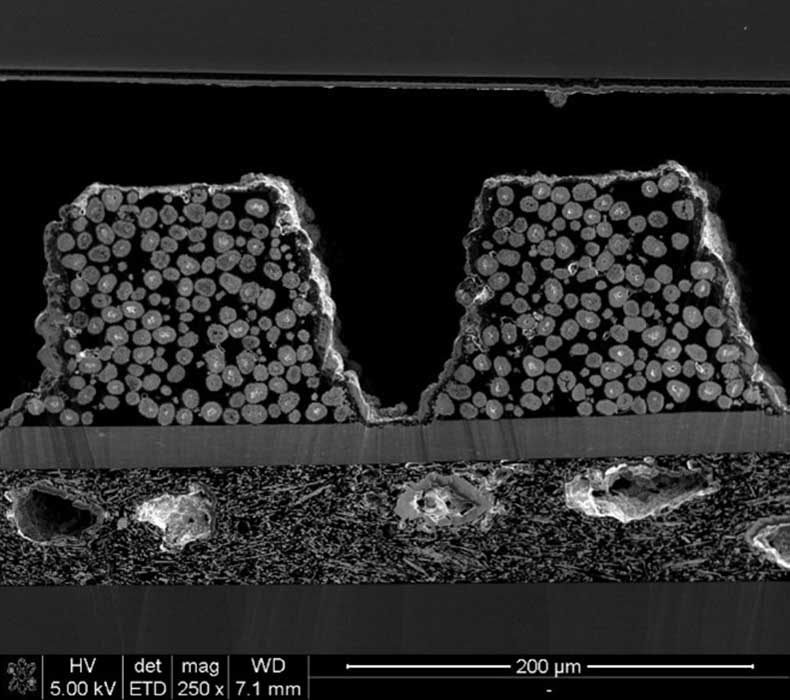High-Throughput Laser Processing
NREL’s novel roll-to-roll (R2R) laser-processing methods enable in-line microstructuring of energy materials for improved performance.

NREL researchers (from left) Donal Finegan, Bertrand Tremolet de Villers, and Dana Sulas-Kern stand in front of an R2R system for high-throughput lithium-ion battery electrode processing. Photo by Peter Rupnowski, NREL
Capabilities
Femtosecond laser ablation can be applied to precisely, cleanly, and quickly modify the microstructure of material. This capability is built into NREL’s R2R line and can be applied to modify the microstructure of battery electrodes to improve their operational performance. NREL’s laser ablation and associated capabilities include:
- Benchtop laser ablation
- R2R laser ablation
- Materials characterization
- Electrochemical characterization.
Bench-Top Laser Ablation
Scale-up initiatives for laser ablation of energy storage materials begins at the bench-top level. Here, small quantities of sample material are used to understand the interaction between laser conditions and the energy storage material of interest. Optimal laser ablation conditions for scaling up to R2R manufacturing are found using a bench-top femtosecond laser and the optimized conditions are supported by computational models and materials characterization.
Roll-to-Roll Laser Ablation
Demonstrating scale-up of laser-ablating complex patterns to energy storage materials is key to de-risking the technology for industry partners. Since most battery manufacturing facilities require R2R processing, the lab’s capabilities emulate in-line laser-ablation processing on NREL’s R2R line.

A high-power femtosecond laser is used to introduce laser-ablated features to a continuously moving roll of material. Graphic by Alfred Hicks, NREL

This scanning electron microscope image shows a cross-section view of a lithium-ion battery electrode with laser-ablated micro-structures. Image by Donal Finegan, NREL
Materials Characterization
Understanding the morphological features, such as the porosity and tortuosity, of battery electrodes is critical to validating that laser-ablation is achieving the desired features for improved wetting, formation, rate, and life performance. Materials characterization using X-ray nanocomputed tomography and scanning electron microscopy is also applied to quantify the heterogeneity of features achieved and how they relate to laser-ablation conditions (i.e., process control). NREL researchers also apply chemical and crystallographic analysis techniques such as energy-dispersive spectroscopy and X-ray diffraction to identify any unfavorable changes in material properties from the laser ablation process. These techniques are applied to materials made at both the bench-top and R2R scale.
Electrochemical Characterization
Verifying that laser-ablation techniques have a positive impact on the performance of Li-ion batteries requires cycling the materials in realistic operating environments. NREL researchers build the laser-processed materials into a combination of coin cells and pouch cells for cycle-life evaluation. During electrochemical evaluation, improvements are quantified to power density, energy density, cell impedance, and cycle life of cells between nonablated and ablated materials.
Publications and Patents
Laser Ablation for Structuring Li-Ion Electrodes for Fast Charging and Its Impact on Material Properties, Rate Capability, Li Plating, and Wetting, Journal of Power Sources (2022)
Laser Ablation for Lithium-Ion Batteries, Nonprovisional U.S. Patent Application No. 63/149,466 (Filed 2021)
Sensor-Guided Adaptive Laser Ablation of Battery Electrodes, Provisional U.S. Patent Application No. 63/284,144 (Filed 2021).
Read more publications from NREL's Advanced Manufacturing Program.
Partnerships
NREL's advanced manufacturing researchers work with many partners on laser ablation within the energy industry, government, and academic institutions. This work is supported jointly by the U.S. Department of Energy's Advanced Materials and Manufacturing Technologies Office and Vehicle Technologies Office through a cost-share project with companies Clarios, Amplitude, and Liminal.
Learn how to work with NREL or use the contacts below.
Contact
Share
Last Updated Dec. 31, 2024
